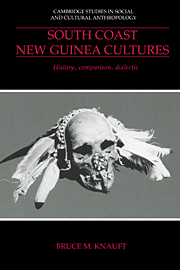Book contents
- Frontmatter
- Contents
- List of figures
- List of tables
- Acknowledgments
- 1 Language-culture areas of south coast New Guinea
- Part 1 Grounding
- Part 2 Critique
- Part 3 Reconfiguration
- 7 Theoretical reconfiguration
- 8 Marind-anim
- 9 Symbolic and sociopolitical permutations
- 10 Regional characteristics and comparisons
- Appendix: evidence concerning Asmat homosexuality
- Notes
- List of references
- Index
- Cambridge Studies in Social and Cultural Anthropology
8 - Marind-anim
from Part 3 - Reconfiguration
Published online by Cambridge University Press: 04 December 2009
- Frontmatter
- Contents
- List of figures
- List of tables
- Acknowledgments
- 1 Language-culture areas of south coast New Guinea
- Part 1 Grounding
- Part 2 Critique
- Part 3 Reconfiguration
- 7 Theoretical reconfiguration
- 8 Marind-anim
- 9 Symbolic and sociopolitical permutations
- 10 Regional characteristics and comparisons
- Appendix: evidence concerning Asmat homosexuality
- Notes
- List of references
- Index
- Cambridge Studies in Social and Cultural Anthropology
Summary
Marind-anim provide a convenient point of departure for reconfiguring the comparative analysis of south coast New Guinea. Marind customs and beliefs emphasized themes found in different permutations elsewhere along the south coast, and their sociopolitical and mythic features were both dramatic and distinctive during the early colonial period. Available information is ripe for reconsideration, since the relevant details are meticulously documented but deeply ensconced in van Baal's (1966) huge and wonderful but digressive and complicated compendium of Marind ethnography.
Dema
To comprehend Marind-anim, as van Baal emphasizes, we must start with dema. Dema were at once primordial ancestors, living spirits, clan totems, timeless originators of the universe, and continuing forces of power, awe, and change within the cosmos. The relationship of dema to Marind was not only one of descent but transcended boundaries of linear chronology and social space. Dema created the places of the known world. The stories of their travels, adventures, and torments were a continuing myth-space that engaged all four Marind phratries and moved across the territory in ritual enactment. Girls and particularly boys were indoctrinated and socialized into the dema's way of life; in addition to being initiated into the world of dema-stories and ritual embodiments, they re-learned how to drink water, eat food, gather coconuts, clothe themselves, and obtain enemy heads as taught by the dema.
- Type
- Chapter
- Information
- South Coast New Guinea CulturesHistory, Comparison, Dialectic, pp. 136 - 171Publisher: Cambridge University PressPrint publication year: 1993



